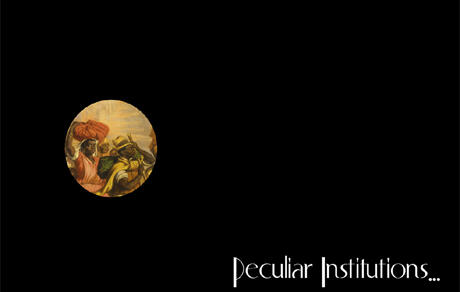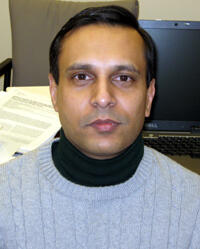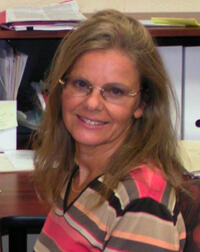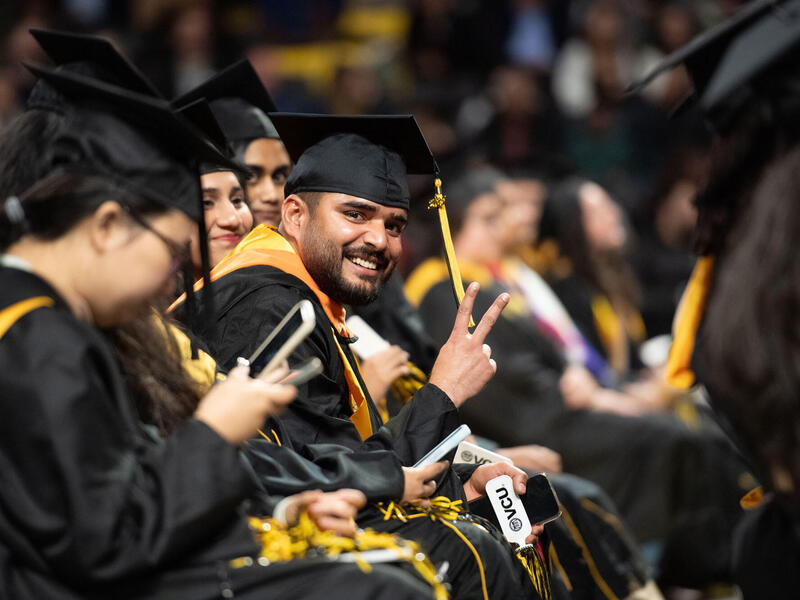Jan. 21, 2009
January faculty and staff features
Share this story

Sanford Biggers, assistant professor of sculpture, School of the Arts
Biggers’ installation exhibition, “Peculiar Institutions,” is showing at Solvent Space in Richmond through Feb. 28. “Peculiar Institutions” reflects on the history of Richmond’s slave market, mediating the experience through historical and contemporary iterations of race relations and history. “Peculiar Institutions” highlights Biggers’ ability to blend meditative, historical and contemporary issues.
Sherry Blankenship, assistant professor, School of the Arts, Qatar
Blankenship was honored with an Award of Excellence for Print at the 38th Annual University and College Designers Association conference in Savannah, Ga. Blankenship's entry, “Design at the Crossroads: the Intersection of Change and the Future,” was used as the publication for VCUQatar’s 2008 annual Tasmeem Doha International Design Conference. Blankenship used a palette of colors derived from the arts of the Middle East.
Devanand Sarkar, Ph.D., Department of Human and Molecular Genetics, VCU School of Medicine, the VCU Institute of Molecular Medicine, and the Harrison Endowed Scholar in Cancer Research at the VCU Massey Cancer Center

Sarkar, an assistant professor in the Department of Human and Molecular Genetics, was recently awarded a three-year grant from The Dana Foundation totaling $200,000 to develop a gene therapy strategy as an effective treatment for malignant gliomas, a type of brain tumor.
According to Sarkar, his team will examine a novel therapeutic regimen combining gene therapy and immunotherapy in a single agent. The agent is known as Ad.PEG-E1A-mda-7. Their hope is that it may significantly enhance the therapeutic efficacy of the gene therapy.
Sarkar and his team will evaluate the eradication efficacy and vaccine effects of Ad.PEG-E1A-mda-7 in animal models using human and mouse glioma cells. These preclinical studies have direct relevance to the progression of brain tumors and will help gather essential baseline information to develop a Phase I/II clinical trial for translation of this approach in malignant glioma patients.
According to Sarkar, one major problem with adenovirus-based gene therapy in general is that when delivered intravenously, the adenovirus is removed from the circulation by the liver and very little reaches the target tumor tissue. Since brain tumors infiltrate into the surrounding tissue the tumor cannot be completely removed by surgical resection. Following surgical resection, the adenovirus can be directly injected into the remaining tumor tissue thus significantly increasing payload delivery to the target tumor tissue and preventing recurrence.
Blue Wooldridge, DPA, professor, L. Douglas Wilder School of Government and Public Affairs
The National Academy of Public Administration has named Wooldridge chair of its Standing Panel on Social Equity in Governance. The nonprofit NAPA is an independent coalition of public management and organizational leaders. Wooldridge’s duties will include reviewing and evaluating developments in public administration, evaluating the academy’s problem-solving activities and identifying ideas, issues and projects in social equity and governance.
Susann Cokal, assistant professor, Department of English
A frequent contributor to The New York Times Book Review, Cokal’s presence in the prominent publication was twofold this past weekend. Her analysis of Stacey D’Erasmo’s “The Sky Below” landed the coveted cover spot of the Jan. 11 issue. In a separate piece, the Book Review revisited Cokal’s 2005 novel, “Breath and Bones,” the story of a 19th century painter’s muse. Cokal offers special insight into D’Erasmo’s writing, the Book Review noted, as both authors illustrate how art has the potential to transform personal loss. To read Cokal’s review of “The Sky Below,” visit http://www.nytimes.com/2009/01/11/books/review/Cokal-t.html?ref=review. To read the mini-profile of Cokal’s “Breath and Bones,” visit http://www.nytimes.com/2009/01/11/books/review/Upfront-t.html?ref=review.
Sonya Clark, professor and chair, Department of Craft/Material Studies, School of the Arts
Clark’s exhibition, “Loose Strands, Tight Knots,” which was shown at the Walters Art Museum in Baltimore, was selected as one of the city’s 10 best art shows of 2008 by Baltimore City Paper. “Loose Strands,” which traced a history of art through human hair, “reminds us of the symbolic power of our bodily excesses over the course of centuries, and accents our own intimate connection with our own hair and the hair of loved ones,” according to the publication.
Alenka Luzar, Ph.D., Department of Chemistry

Luzar, professor of chemistry, has been named a Fellow of the American Physical Society. Luzar was selected by her peers in the field of chemical physics for her “elegant and pioneering contributions to the fundamental theory of aqueous interfaces, dynamics of hydrogen bonds in condenses phase systems, phase behavior of confined water and kinetics of aqueous self-assembly.”
Luzar, who has been with VCU since 2004, specializes in physical, theoretical and computational chemistry and chemical physics. Through a combination of computations, theoretical and experimental approaches, Luzar and her team are focused on understanding the dynamics and structure of molecular liquids, such as water, hydrogen-bonded mixtures, and intermolecular and intersurface forces in biological, complex fluid and materials systems. Luzar’s research is supported by grants from the National Science Foundation.
According to Luzar, understanding the basic mechanisms involved in hydration processes in biology and nanotechnology takes researchers a step closer to creating new biomimetic materials, harvesting energy from nature and storing energy.
Each year no more than one half of 1 percent of the society membership is recognized by their peers for election to the status of Fellow in the American Physical Society.
Luzar’s early theoretical contributions to hydrophobic interaction and dynamic behavior of hydrogen bonds in condensed phase systems are widely cited in textbooks and journals, and used extensively by scientists working in these fields. She collaborated with colleagues in the Physics Department at the University of Puerto Rico and the College of Chemistry at University of California at Berkeley on this work.
Luzar will receive a fellowship certificate in March during the APS Annual Meeting in Pittsburgh.
Javier Tapia, associate professor, School of the Arts
Tapia has five large paintings in a show at the Reynolds Gallery in Richmond through Jan. 17. The show is titled “New Watercolors.”
Ron Johnson, assistant professor, VCU School of the Arts
“Everybody Wants the Other,” a series of Johnson’s large-scale drawings, is on view in Washington and Lee’s Wilson Hall through Jan. 30. The site-specific drawings were created on Mylar, a translucent film, and range from 10 to 18 feet long. The pieces are hanging in the four-story-tall Lykes Atrium.
Hope Ginsburg, assistant professor, School of the Arts
Ginsburg will host a five-day “Sponge” workshop, an experience in total immersion, at the Center for Advanced Visual Studies at MIT on Jan. 26-30. “Center Sponge” will string together encounters with the ocean floor, outer space, maple sugaring and singing in the rain. The workshop follows the model of previous sponge workshops Ginsburg has developed, including “spongespace” at VCU’s Solvent Space in 2008. Sponge is an artwork and model for knowledge exchange sustained by public participation. “Center Sponge” will include visiting expert presentations, film screenings, one intensive ukulele lesson and three field trips.
William Walker, M.D., Department of Physical Medicine and Rehabilitation
Walker, endowed Ernst and Helga Prosser professor and medical director of the VCU Rehabilitation and Research Center, received the Mitchell Rosenthal Award for best research paper of 2006 and 2007 from the nationwide Traumatic Brain Injury Model Systems database. The paper, "Occupational Categories and Return to Work after Traumatic Brain Injury: A Multicenter Study,” was published in the December 2006 issue of Archives of Physical Medicine and Rehabilitation.
In the study, Walker and his team examined whether the type of job a person had before a traumatic brain injury (TBI) influences his work disability. The team reported that people with manual labor jobs are at the highest risk for remaining out of work one year after TBI, while professionals/managers have the best rate of return to work.
“This knowledge should improve disability counseling for patients and their families after severe TBI and ultimately lead to advances in their vocational rehabilitation,” Walker said. Walker received a plaque at the TBI Model Systems’ project directors meeting in Washington, D.C., in December. The TBI Model Systems program is a national collaboration of 17 medical rehabilitation centers funded by the U.S. Department of Education, Office of Special Education and Rehabilitative Services, and the National Institute on Disability and Rehabilitation Research.
Subscribe to VCU News
Subscribe to VCU News at newsletter.vcu.edu and receive a selection of stories, videos, photos, news clips and event listings in your inbox.





